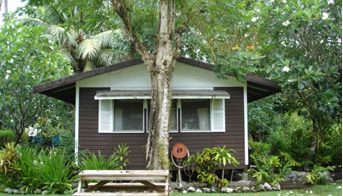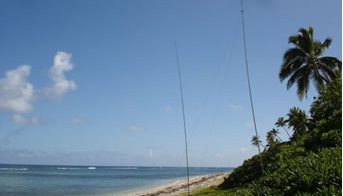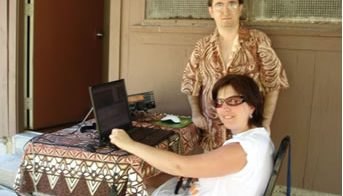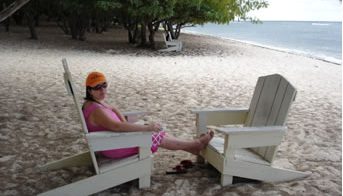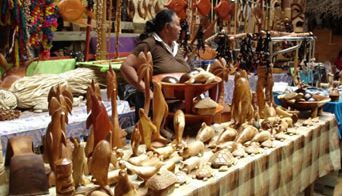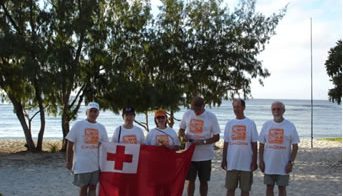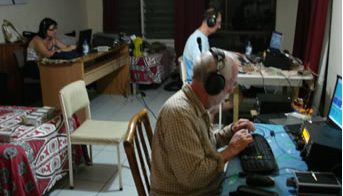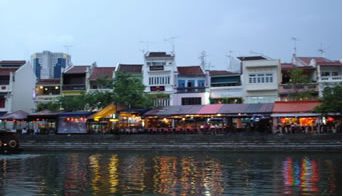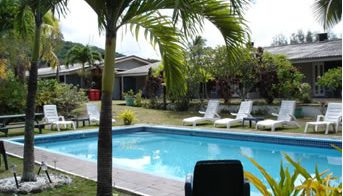Andrea Panati IK1PMR & Claudia Fava PA3LEO
After four DX trips across Oceania in the last decade, we still had the desire to visit new and interesting Pacific islands, in particular Tonga, the only Kingdom in Oceania, a country rich with traditions, and never ruled by any European empire.
Travel plans
A Pacific tour starting from Europe is always demanding, but time was not an issue for us, and within budget for a lightweight expedition (i.e. not requiring any advance shipping of equipment).
In particular, we found a convenient way to travel Round-The-World (RTW) with a single ticket from Air New Zealand, which allows for several stopovers in the Pacific.
With no time constraints (and no additional transport costs) our plan evolved to a RTW trip including a visit to Los Angeles (for logistic reasons), Samoa 5W (just on the way to Tonga!), Tonga A3 itself, New Zealand (being Auckland the airline hub), Cook Islands E5 (included in the ticket mileage at no extra cost) and Singapore 9V (an interesting country to visit on the way back to Europe). All these flights, departing/arriving in London, were on sale at around 1100 Euro (plus taxes) with a 46kg baggage allowance.
The team
So we had a plan, an easy way to travel (scheduled flights), easy licensing, most of the equipment at hand (Elecraft K3 and K2 transceivers, a Tokyo Hy-Power solid state amplifier, the usual fiberglass masts and wires).
Still missing was the team. Our focus is on CW and RTTY modes, and Europe. Claudia PA3LEO/K2LEO has accompanied me in many DXpeditions, becoming quite well known in the RTTY circles for her digital operations from all continents: TY, JT, VU4, 3D2, CX, ZP, 9H, etc.
Finding additional members proved more difficult, as everyone seems lacking time. We decided to go ahead with planning anyway: we would make the Pacific DX trip as a duo or as a larger group.
In Summer 2009 we announced our plans and intention to go on a long Pacific DXpedition on our web site (www.ik1pmr.com) together with an open invitation to any ham to join the DXpedition (an experiment we plan to do again, perhaps encouraging more the young ham community). Soon the information was spread on major DX web sites (special thanks to Col MM0NDX).
It didn’t take long for the first application to arrive: on a morning walk along one of the many nice canals in Amsterdam, we received a mobile phone call from Wil PA0BWL, recently retired, hoping to go on his first international DXpedition.
Soon after, Franz OE2SNL joined the group by talking with us on skype; he had previously activated Samoa and Easter Island on a solo trip. Then Gerd DJ5IW (member of few Pacific expeditions), and Norbert DJ7JC (also member of the 3D20CR crew) completed the group. Others were willing to join the team, but had last minute issues forcing them to postpone such adventure.
One of them is Kenneth OZ1IKY: we had the luck to meet him in person in August during our Summer vacation in Copenhagen. He turned out to be one of our main supporters, building and testing several wire antennas for us, and promoting our DXpedition with the Danish DX Group. A special thank to them all.
Licensing and equipment
From July to early November it was a very busy time for us. First dealing with licenses for each team member and DXCC entity (5W, A3, E5, 9V) except ZL which has implemented CEPT operations.
Contacting the licensing authorities was sometimes time consuming but we always found friendly officers and also local hams helping us. Many thanks to Mr Feao Vakata (Tongan licensing authority), Victor E51CG and Peter 9V1PC for their support.
Next, we had to define the equipment list, and buy or build all the required parts. The radios were all Elecraft K3, with an excellent modern high performance receiver, reliable and lightweight, plus a spare Elecraft K2. Antennas were all home-made wire antennas, mainly ¼ wave verticals (sometimes we used two phased verticals) mounted on fiberglass masts.
Kenneth and Wil made most of the antenna work before departure, and our friend Con DF4SA sponsored some excellent masts with his business (www.spiderbeam.net).
The main requirements for our antennas were: simplicity, efficiency and reliability. Simplicity means lightweight stuff (to avoid extra transport costs), easy to assemble and put down (several times!) to save time and fatigue. Efficiency, when operating from a Pacific island, implies that vertical arrays near the ocean perform better than yagis at low elevation above ground. Reliability is a consequence of simplicity and home-made approach: avoiding any unnecessary “special” item that may fail, and anything that is not extremely resistent to the combination of high humidity, salt water and strong sun (elements that are always present in the South Pacific and should not be underestimated). After all, our equipment has to survive 6 intense weeks around the Pacific, several install/dismantle phases, and daily usage – DXing for a period of 40 days from 6 different DXCC entities is hard, both for the operators and for the equipment!
To round up the setup, we had 3 lightweight solid state amplifiers, 400 meters of lightweight coax cable, phasing lines and receiving antennas (beverages and curtains) – both amplifiers and RX antennas proved to be important items for a Pacific DXpedition near a sunspot minimum.
Obtaining sponsorships was another important activity. We were lucky to receive support from most DX groups, especially from Europe (our main geographic target – considering the difficult path from the South Pacific).
The trip
On November 8 three of us (Claudia, Wil and I) departed from Amsterdam with about 40kg of baggage each; greatly exceeding our hand baggage limits was the norm during this long trip – I remember climbing the airplane stairs so many times with a complete HF station: Elecraft K3, power amplifier, headset, all essential cables and interfaces – trying to hide the fact that 18kg are a bit more than what I easily handle. Smiling, talking and being patient (i.e. ready to wait for unspecified periods of time) always worked well with customs and airline staff in the Pacific (not the same in Europe, where time seems always scarce, everyone is a numbered customer and in the end everything has a price).
In London we met Norbert, and continued together to reach Los Angeles. Here we spent two pleasant days with Bradley W6TJI and his wife Mary (who is also an excellent chief in the kitchen). Their outstanding hospitality is hard to describe: they even stored part of our items for weeks (to allow us to pick them up and avoid extra costs), they donated us small and large bags, helped us find missing items, allowed us to operate from their shack, and so on. It was certainly the most lucky and comfortable part of our long trip! Thanks again Bradley and Mary.
Western Samoa
The flight to Samoa was long but OK. On our arrival at Apia airport, we found the usual informal customs (friendly, curious and no problems) and the usual singers/musicians that are typical of most Pacific islands. Then a taxi ride to the resort, and soon after a visit to the local Telecom Office to pickup our licenses; all documents were ready and waiting for us, we only had to pay the fees. After few pictures, we were ready to go and setup our stations.
In all the places we stayed we had no problems with owners or managers regarding our antennas and cables; everyone was friendly and in most cases even already familiar with amateur radio! Of course we wrote them in advance about our plans to install antennas, to avoid surprises on place – I even sent some pictures of previous setups to help explain what we mean with “antennas” (not just a small aerial but wires stretching over hundreds of square meters).
The resort was basic but well run by Nigel, the owner of New Zealand origins. Apia was a few minutes car ride, providing markets, restaurants (even a McDonalds nowadays) and banks. Our main problem operating from 5W was local power line noise – all power lines are unshielded overhead, and we had them all around. An excellent receiver is essential in such conditions.
One of our bungalows in Apia, Samoa.
Tonga
One week later we took the same flight, going on to Tonga in just 1.5 hours. Similar customs and musicians at the airport, similar taxi van transfer to the “resort”. Our QTH here was a really basic place with no air-conditioning, small bungalows on the beach, no internet connection, in a rural area. It was the cheapest we found (something to consider for a 14 days stay as part of a 6 weeks tour), and provided a quiet and spacious sea-front environment for our setup. There were no other guests during our stay, except at weekends.
It was a great pleasure to receive a visit by Dave A35KL, an experienced skipper often sailing the South Pacific as well as operating ham radio from Tonga. Of course I was already in contact with him.
Local time in Tonga is 12 hours ahead of Central European Time. Our typical day starts around 8am (after a busy night spent dealing with European pileups), waiting for our breakfast, which may take from 15 minutes to 2 hours – it depends on the person in charge, the weather, and especially the availability of ingredients – that often have to be collected daily based on our orders. The funny aspect is that you never know if what you ask for is in stock (in the kitchen) or not, because the staff even doesn’t know, and they don’t consider it necessary or convenient to check and inform you about what is available; they simply go shopping for the necessary items (to a nearby village perhaps) and come back when done! Waiting one or two hours for an egg is not uncommon, and nothing one should be surprised or worry about in rural Tonga – here you simply learn what “Tonga time” means (time of the day has a very scarce relevance in most Pacific islands, if you’re not a DXer at least!). The breakfast experience is just one of the many daily exercises that really can teach you (i.e. any developed world citizen) what “relax” and “patience” really mean, and more generally how we are used to be dependent on time constraints.
Late mornings provide QSOs with Japan and USA on the higher bands, midday is a slow time for DX, then the bands gradually open to Russia and the Middle East in the afternoon, and then to Western and Northern Europe before our sunset (UTC morning hours) and pileups become fearce and can go on all night. Conditions are different each day of course, but often all HF bands from 80m to 17m were open simultaneously to Europe around our sunset – this is a great time for DX (and for mosquitos). Openings on 40m to 20m may last several hours during our night; then before sunrise also 160m and 80m may be good for (part of) Europe, especially Russia, and the Baltic countries. From rural Tonga we enjoyed lower noise levels than Samoa, and lower humidity levels too.
To interrupt the monotony, often we took a taxi to Nuku Alofa, the capital city – indeed a small town, where one can find a couple of cafes, banks and internet service. The most interesting experience was probably the local market, where nice wooden handcrafts are available for very reasonable prices. I particularly like the tikis (and collect them from different Oceania islands). Buying something at the market is an experience in itself; very often vendors have absolutely no money at hand and have to go around asking for some change – it takes an unpredictable amount of time as usual, but business always happens in a friendly and safe manner.
Some of our beachfront verticals in Tonga.
Claudia PA3LEO (waiting for 17m RTTY to open to EU) and Andrea IK1PMR. Moving the station outside the bungalow was often necessary during the day, due to high temperatures (the amplifier is not shown in the picture, it was inside the room).
Our QSL Manager relaxing on the beach, Tonga.
The market in Nuku Alofa, capital of Tonga.
The group on the beach with Tonga flag. From the left: Franz OE2SNL, Andrea IK1PMR, Claudia PA3LEO, Wil PA0BWL, Gerd DJ5IW, Norbert DJ7JC.
Waiheke Island (OC-201)
After two weeks in Tonga, we moved to New Zealand. Instead of Auckland, we planned to stay on the beautiful island of Waiheke (where we also stopped on our 2008 Pacific trip). It is easily reachable by regular ferry in 35 minutes – it’s so close to Auckland that it’s now considered a suburb of the city, still it offers a much greener and more relaxed lifestyle.
We spent only 4 nights on Waiheke, mainly sightseeing and recovering from the first half of our long DX Round-The-World trip. Still we were active at night, especially on 30m and 40m for Europe, with simple verticals.
A visit by Jim ZL1LC was greatly appreciated. He published an article about us on the New Zealand ham magazine Break-In (Jan-Feb 2010).
View from our chalets on Waiheke Island (OC-201), New Zealand.
Rarotonga (South Cook Islands)
On December 7 we moved back to Auckland and then took the flight to Rarotonga (Cook Islands). We received the usual warm welcome at the airport, including flower necklaces.
Our QTH here was the KiiKii Motel, easily reachable by bus and located just ocean front. In addition, the manager is very ham friendly – several hams operated from this motel before us.
Compared to 5W and A3, here we had no power grid limitations and no mosquitos – two big advantages. Rarotonga looks more touristic and has more modern infrastructures than most South Pacific countries. Despite the fatigue resulting from a six-weeks DX trip, we had an intense ham activity from E5, mainly focusing on Europe on 80m, 40m and 30m simultaneously (from our sunset till late night). Sometimes the storms were very noisy, making it impossible to copy any DX signal.
We had the pleasure to meet Victor E51CG and Jim E51JD, who supported us in several occasions. Then it was time to dismantle the setup and start our long trip back home.
Targeting Europe on 3 bands from Rarotonga (E5): Claudia E51LEO (30m RTTY), Norbert E51NAA (40m CW) and Gerd E51XIW (80m CW). The callsigns we used were tied to band/modes, to reduce the number of dupes.
Our motel in Rarotonga (South Cook Islands).
Singapore Claudia and I had a stop in Singapore for 3 days. We applied for 9V1 licenses in advance, and we were so lucky to enjoy the great hospitality by Peter 9V1PC and his family.
We enjoyed both sightseeing (Singapore is a very multicultural and interesting island), dining with ham friends, and comfortably DXing from this exotic land, adding a new one to our list of activated DXCC countries (the complete list is on www.ik1pmr.com – we hope to activate 100 DXCC entities soon or later, so next one might be your home country!).
Singapore from the boat. We operated as 9V1/IK1PMR and 9V1/PA3LEO (a license was required, no CEPT).
The end
On 18 December, after 40 days of DXing and over 35000 QSOs from the Pacific, we’re finally back to a much colder Amsterdam, where few boxes full of QSL cards have already arrived. We had a snowy Christmas, and few days later we moved to Tenerife.
Many thanks to our generous supporters (too many to list all) including: Chiltern DX Club, German DX Foundation, European DX Foundation, Swiss DX Foundation, VERON Oss, BARTG, Danish DX Group, ARI Casale Monferrato, Nippon DX Association, DX Engineering, Elecraft, Intrograf.com.pl (QSL printing), and our friends Robert SP5XVY, Leszek SP3DOI, Kenneth OZ1IKY, Istvan HA0DU, Peter SV0XAW, Bradley W6TJI, Peter 9V1PC, Dave A35KL and DXers worldwide who provided valuable support.

